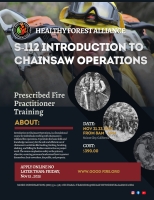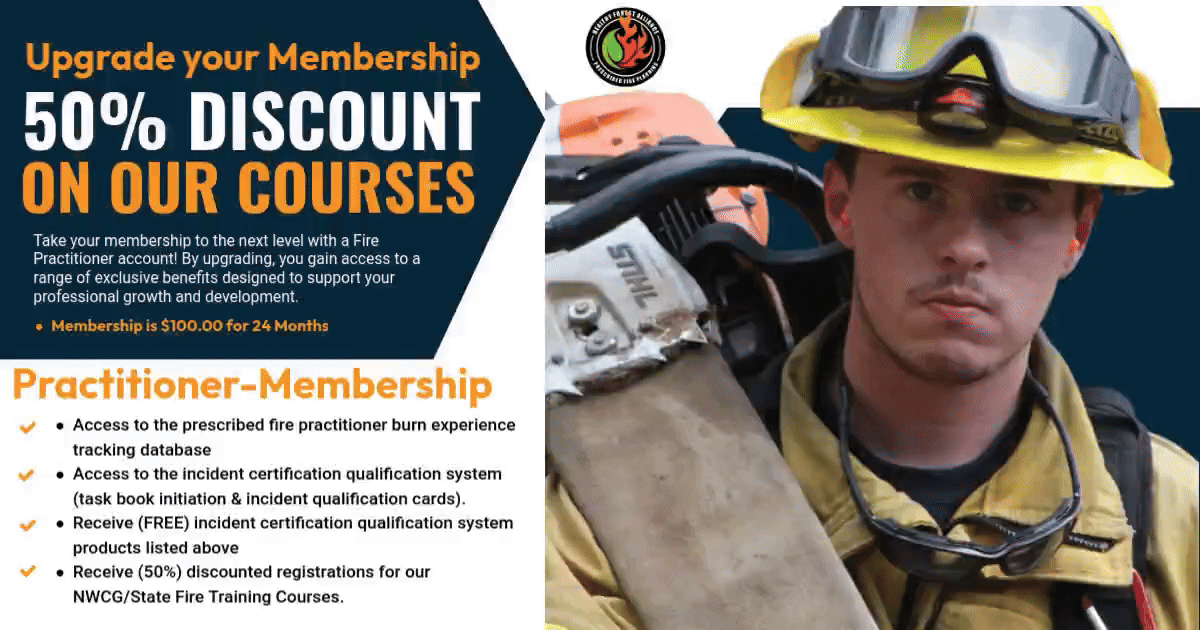"Empowering Excellence, Uniting Expertise: Igniting Tomorrow's Fire Practitioners"
FIREFIGHTER TRAINING COURSES & REQUIRED MATERIALS
Firefighter Type 2 (Blended)
Course Description: The Basic Wildland Firefighter Training is designed to equip participants with the fundamental knowledge and skills required for effectively responding to wildland fires. This blended course combines online modules with practical field exercises to ensure a comprehensive learning experience. A blended Basic Wildland Firefighter course combines online learning with hands-on practical training. Students will have to complete the online course listed below, and attend the two day skills evaluation days to complete the course.
Target Group: individuals seeking entry-level positions in wildland firefighting who prefer a blended learning approach, combining online modules with in-person practical training.


Wildland Firefighter Work Capacity Test
Course Description: The Wildland Firefighter Work Capacity Test (WCT), also known as the "Pack Test," assesses a firefighter's physical fitness to meet the demands of wildland firefighting duties. It involves a timed walk while carrying a weighted pack, with different levels corresponding to different duty types: Arduous (3 miles in 45 minutes with a 45-pound pack), Moderate (2 miles in 30 minutes with a 25-pound pack), and Light (1 mile in 16 minutes, no pack). Successful completion of the appropriate WCT level is a prerequisite for many wildland firefighting positions.
Target Group: The Wildland Firefighter Work Capacity Test (WCT) is designed for different groups of individuals involved in wildland fire management, depending on their assigned duties.
Wildland Fire Safety Training Annual Refresher (RT-130)
Course Description: The intent of RT-130, Wildland Fire Safety Training Annual Refresher (WFSTAR) is to focus line-going personnel on operations and decision-making issues related to fireline safety in order to recognize and mitigate risk, maintain safe and effective practices, and reduce accidents and near misses.
Target Group: RT-130 is required for designated positions in order to maintain currency, for all personnel assigned to positions with fireline duties, and for any position assigned to the fireline for non-suppression tasks.
Note: Firefighters who receive initial fire training are not required to take RT-130 in the same calendar year.


CA-219: Wildland Firefighting - Firing Operations
Course Description: This course provides information and develops skills required to perform and hold firing operations on wildland fires and prescribed burns. This course contains a mix of online and instructor-led training including live fire exercises. The students will be engaged in wildland firefighting and firing operations. Students are required to complete the online training portion of the course and pre-course quizzes prior to taking the instructor-led training. This course meets and exceeds the objectives of the NWCG S-219 Firing Operations (2014) course.
Target Group: The CA-219: Wildland Firefighting - Firing Operations course targets personnel seeking to become qualified as Firing Boss, single resource (FIRB) and Firefighter Type 1 and 2 personnel aiming to gain experience in firing operations. This includes those involved in both wildland firefighting and prescribed burns.
ICS 200: Basic Incident Command System for Initial Response
Course Description:
This course reviews the Incident Command System (ICS), provides the context for ICS within initial response, and supports higher level ICS training.
Target Group:
This course provides training on, and resources for, personnel who are likely to assume a supervisory position within ICS.
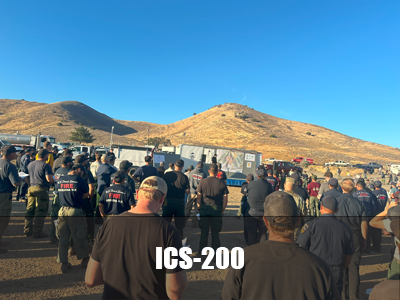

ICS 300: Intermediate Incident Command System for Expanding Incidents
Course Description:
This course provides training for personnel who require advanced application of the Incident Command System (ICS). This course expands upon information covered in the ICS 100 and ICS 200 courses. Individuals who may assume a supervisory role in incidents. Note: During a Type 3 incident, some or all of the Command and General Staff positions may be activated, as well as Division/Group Supervisor and/or Unit Leader level positions. These incidents may extend into multiple operational periods.
Target Group: Individuals who may assume supervisory roles in incidents that are expanding and potentially extending into multiple operational periods.
Incident Safety Awareness for Hired Vendors
Course Description:
This course provides an awareness of fireline and incident safety to hired vendors who plan to engage in wildland fire suppression and other incident support activities. It includes an overview of hazards and safety issues, entrapment avoidance, incident organization, fire shelter deployment, and current issues.
Target Group:
Hired vendors working with the California Department of Forestry and Fire Protection (CAL FIRE) or the United States Forest Service (USFS) on any active incident, including water tender operators, heavy equipment drivers or operators, crew bus drivers, vehicles with a driver, mechanics, fallers, and swampers
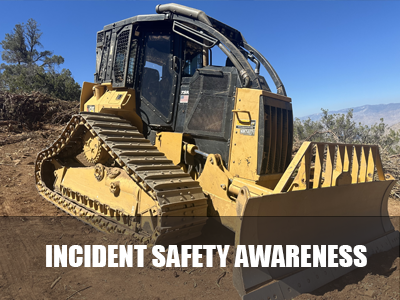

L-280: Followership to Leadership
Course Description:
This training course is designed as a self-assessment opportunity for individuals preparing to step into a leadership role. The course combines one day of classroom instruction followed by a second day in the field with students working through a series of problem solving events in small teams (Field Leadership Assessment Course). Topics include leadership values and principles, transition challenges for new leaders, situational leadership, team cohesion factors, ethical decision-making, and after action review techniques. Some course delivery may be arduous in nature.
Target Group:
Personnel desiring to be qualified as a single resource boss.
M-410 Facilitative Instructor
Course Description:
This 40-hour training course is designed to help students become effective facilitative instructors. The purpose of this course is to improve training quality by presenting instructional methods with an emphasis on student-oriented adult training techniques.
Target Group:
This course is designed for students to meet NWCG instructor requirements.
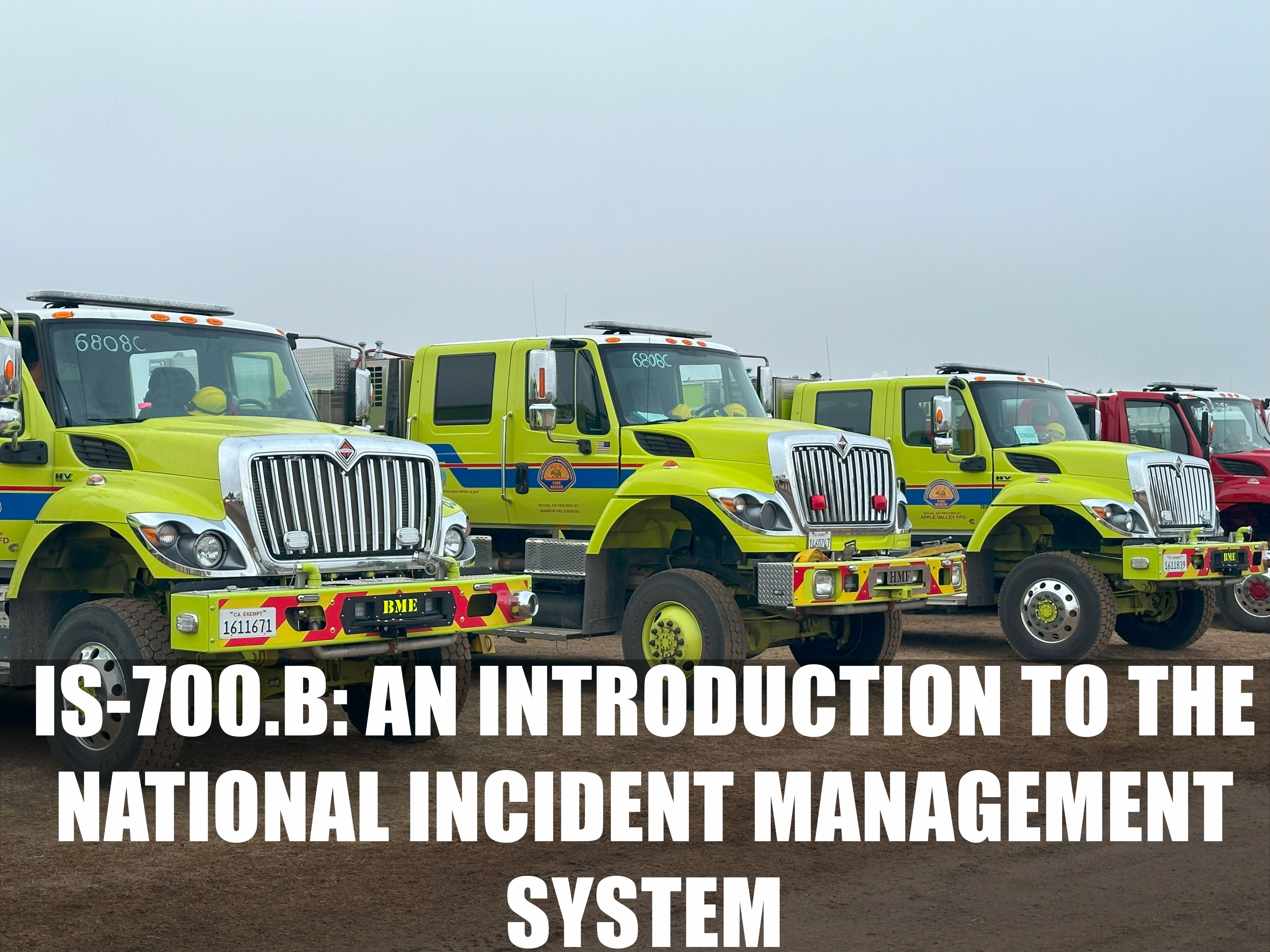
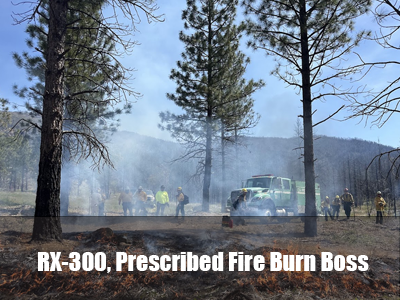
RX-300, Prescribed Fire Burn Boss
Course Description:
RX-300 Prescribed Fire Burn Boss will provide students with the knowledge, skills, and attitudes to prepare, critically evaluate, and implement a prescribed fire plan in accordance with the NWCG Standards for Prescribed Fire Planning and Implementation, PMS 484.
Target Group:
Personnel desiring to be qualified as Prescribed Fire Burn Boss Type 2 (RXB2). Additionally, agencies, organizations, or personnel who are involved in the preparation, implementation, or review of prescribed fire plans, such as air regulators, fire ecologists, landowners, prescribed fire consultants, fire planners, and others, may also benefit from the course.
RX-310 Introduction To Fire Effects
Course Description:
This course is designed to provide students with the knowledge and skills necessary to recognize and communicate the relationships between basic fire regimes and fire effects, the effects of fire treatments on fire effects, and to manipulate fire treatments to achieve desired fire effects. In an effort to maintain the currency and relevancy of the course materials for RX-310, Introduction to Fire Effects the instructional design has been modified to allow instructors to develop materials based on current information, changing technologies, and the needs of the students.
Target Group:
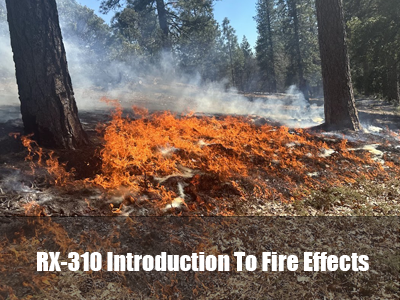
M-410 Facilitative Instructor
Course Description:
This 40-hour training course is designed to help students become effective facilitative instructors. The purpose of this course is to improve training quality by presenting instructional methods with an emphasis on student-oriented adult training techniques.
Target Group:
This course is designed for students to meet NWCG instructor requirements.

S-200 Initial Attack Incident Commander Type 4
Course Description:
This course is designed to meet the training needs of the incident commander type 4 (ICT4). It is presented in a discussion/exercise format. The six instructional units include Foundation Skills; Intelligence Gathering and Documentation; Size Up the Incident; Develop a Plan of Action; Post-fire Activities; Evaluating Incident Objectives and Manage the Incident. Evaluation of the student is by unit tests and performance based evaluations.
Target Group:
Personnel desiring to be qualified as Incident Commander Type 4 (ICT4).
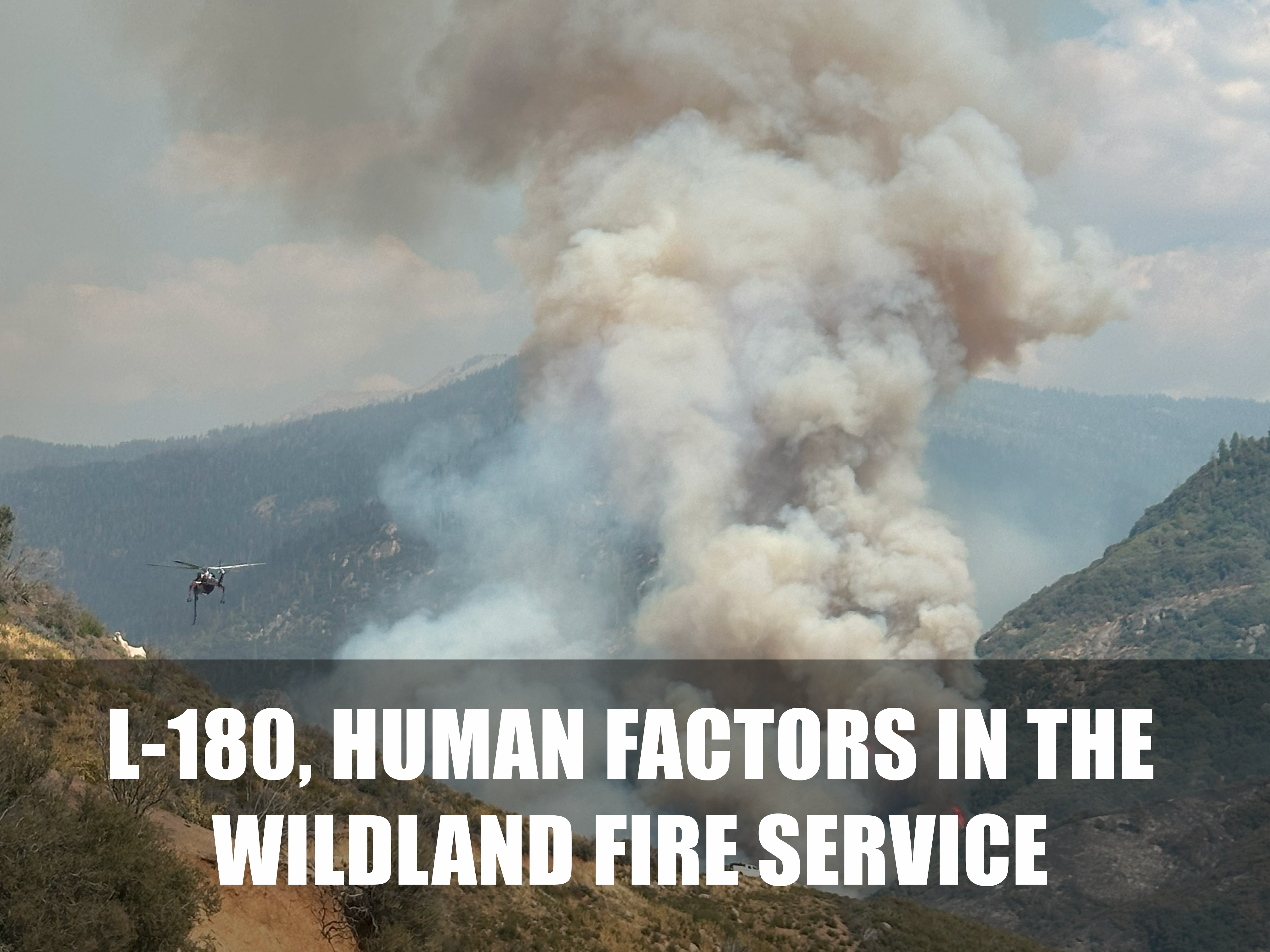

S-112, Introduction to Chainsaw Operations (Blended)
Course Description: Introduction to Chainsaw Operations, is a foundational course for individuals working with chainsaws in wildland fire operations. It provides the basic skills and knowledge necessary for the safe and efficient use of chainsaws in activities like bucking, limbing, brushing, slashing, and felling for fireline construction or project work. The course emphasizes safety as the primary objective, ensuring personnel understand how to protect themselves, their coworkers, the public, and property
Target Group: Personnel desiring to be qualified as Basic Faller (FAL3).
S-131: Firefighter Type 1
Course Description:
S-131, Firefighter Type 1 is designed to meet the training needs of the Firefighter Type 1 (FFT1) and/or Incident Commander Type 5 (ICT5). Topics include operational leadership, communications, LCES, and tactical decision-making.
Target Group:
Personnel desiring to be qualified as Firefighter Type 1 (FFT1) and/or Incident Commander Type 5 (ICT5).
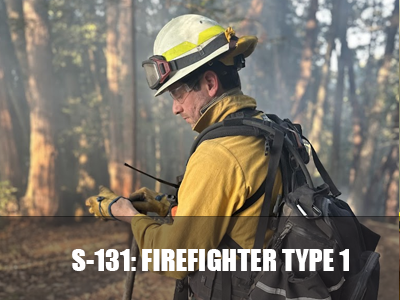
S-211: Portable Pumps and Water Use
Course Description:
This course is designed to provide knowledge and skills to design, setup, operate, troubleshoot, and shut down portable water delivery systems. The focus is on portable pumps – it does not address water delivery for engines. Topics covered include: portable water delivery systems; equipment; roles and responsibilities; and system design and hydraulics. There is also a field exercise where students will apply what they learned in the classroom.
Target Group:
Personnel desiring to be State Fire Training Firefighter 2 or Incident Commander Type 5 (ICT5), or those wanting to learn more about portable pumps and water use.
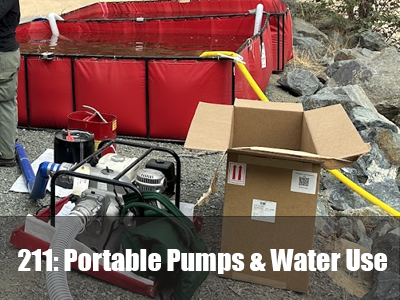
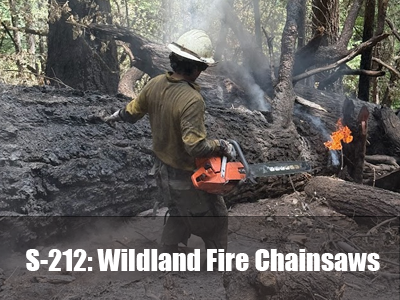
S-212: Wildland Fire Chainsaws
Course Description:
This course is designed to provide knowledge and skills to design, setup, operate, troubleshoot, and shut down portable water delivery systems. The focus is on portable pumps – it does not address water delivery for engines. Topics covered include: portable water delivery systems; equipment; roles and responsibilities; and system design and hydraulics. There is also a field exercise where students will apply what they learned in the classroom.
Target Group:
Personnel desiring to be State Fire Training Firefighter 2 or Incident Commander Type 5 (ICT5), or those wanting to learn more about portable pumps and water use.
S-215 Fire Operations in the Wildland Urban Interface
Course Description:
This is an instructor-led course intended to be presented at the local level. Instructional units include firefighter safety in the interface, managing human factors in the interface, pre-incident planning, sizeup and initial strategy, structure triage, structure protection overview, tactics in the interface, tactical operations and resource use in the interface, action assessment, plan update, and after action review. Designed to assist any emergency responders who will be planning for and making operational decisions during an interface incident.
Target Group:
This course is for personnel desiring to be qualified as Incident Commander Type 4 (ICT4), Task Force Leader (TFLD), or any Strike Team Leader.

S-219 Firing Operations (BLENDED)
Course Description:
This course was developed using a blended approach to learning. Students are required to complete the online training portion of the course prior to taking the ILT. The course introduces the roles and responsibilities of a Firing Boss, Single Resource (FIRB), and outlines duties of other personnel who may engage firing operations. The course discusses and illustrates common firing devices and techniques. Although comprehensive in nature, the course work is not a substitute for the dynamic fire environment. The course provides students with important information regarding general tasks required to be successful. Any opportunity to show students a real ignition or demonstrate the use of an actual firing device will assist in transferring these new concepts and skills to the job. There is an optional field day outlined in the course, it is the discretion of the delivery unit to include the field day; however, if logistically feasible it is suggested by NWCG that a field day be conducted.
Target Group:
Personnel desiring to be qualified as Firing Boss, single resource (FIRB) and Firefighter Type 1 and 2 personnel looking to gain valuable information to conduct or participate in firing operations.
S-230 Crew Boss - Single Resource (BLENDED)
Course Description:
This course is designed to provide students with the knowledge and skills to perform the duties of the Single Resource Boss position, as described in the NWCG Incident Position Standards for Crew Boss, PMS-350-98. Topics include travel and check-in in, briefings, assigning tasks and assessing crew performance, implementing fire line duties, mop-up, firing operations, using aerial resources, medical emergencies, and wildland urban interface.
Target Group:
Personnel desiring to be qualified as any single resource boss.

S-231 Engine Boss - Single Resource (BLENDED)
Course Description:
This is a skill course designed to produce student proficiency in the performance of the duties associated with Engine Boss, Single Resource (ENGB). Topics include engine and crew capabilities and limitations, information sources, fire size up considerations, tactics, and wildland/urban interface.
Target Group:
Personnel desiring to be qualified as Engine Boss, single resource (ENGB).
S-244: Field Observer / Fire Effects Monitor
Course Description:
This course provides students with the skills necessary to perform as a Field Observer (FOBS) and/or a Fire Effects Monitor (FEMO). Topics include roles and responsibilities of the FOBS and FEMO; how to make observations and document those observations; how to produce hand drawn and GPS field maps; and how to navigate using a compass and GPS. The navigation unit has 4½ hours of field exercises and the final field exercise is 8 hours. For pre-course work, students need to read and complete exercises in Basic Land Navigation, PMS 475.
Target Group:
Personnel desiring to be qualified as Field Observer (FOBS) and/or Fire Effects Monitor (FEMO).
S-245: Display Processor
Course Description:
This course provides students with the skills necessary to perform as a Display Processor (DPRO). Topics include general roles and responsibilities and how to assist the Situation Unit Leader with producing incident maps, inputs for the Incident Status Summary, (ICS-209), and other incident products. The final exam is three hours. For pre-course work, students need to read specific chapters in Basic Land Navigation, PMS 475.
Target Group:
Personnel desiring to be qualified as Display Processor (DPRO).
S-270: Basic Air Operations
Course Description:
This course covers aircraft types and capabilities, aviation management and safety for flying in and working with agency aircraft, tactical and logistical uses of aircraft, and requirements for helicopter take-off and landing areas. Note: The regulations, procedures, and policies addressed in this course are primarily those governing federal agency and ICS operations. State, county, or other political subdivisions using this course will need to consult their agency having jurisdiction with respect to regulations, procedures and policies.
Target Group:
Personnel desiring to be qualified as Single Engine Airtanker Manager (SEMG), Helicopter Manager, Single Resource (HMGB), Aircraft Dispatcher (ACDP), and other positions that require basic knowledge of aviation operations.
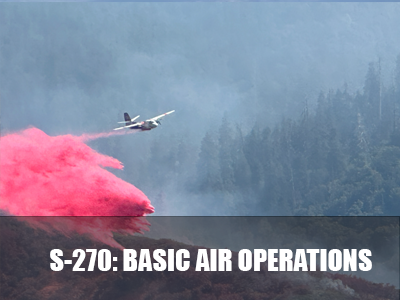

S-290, Intermediate Wildland Fire Behavior (Blended)
Course Description:
This is a skills focused course designed to prepare the developing fireline supervisor to undertake safe and effective fire management operations. It is the second course in a series that collectively serves to develop fire behavior prediction knowledge and skills. The course will train students how to make a thorough, timely assessment of the fire environment and to anticipate changes in fire behavior based on changes in and/or alignment of the fuels, weather, and topography. Students will then practice using this information to support their decision-making and risk management on the fireline.
This BLENDED course is designed to introduce students to the characteristics and interactions of the wildland fire environment (fuels, weather, and topography) that affect wildland fire behavior for safety purposes. Students will also be shown how such information can be applied.
The course is a blended training combining an Online Training (OLT) component and an Instructor-led Training (ILT) component.
Target Group:
Personnel desiring to be qualified as any single resource boss or Fire Effects Monitor (FEMO).
State-Certified Prescribed-Fire Burn Boss (CARX)
Course Description:
Target Group:
UPCOMING TRAINING
S-112 Introduction to Chainsaw Operations
Please Support Our Corporate Members
HELPING LANDOWNERS PROMOTE HEALTHY FORESTS USING "GOOD FIRE"
how you can help
LEARN MORE ABOUT PRESCRIBED FIRE AND HOW IT CAN BE USED TO PROMOTE HEALTHY FORESTS
FROM OUR BLOG
🔥 Small Teams, Big Impact: The Rise of Micro Prescribed Burn Associations Across California,...
“So You’ve Masticated Your Land for Fire Safety… Now What?” Across California, thousands of...
🔥 The Do’s and Don’ts of Pile Burning for Property Owners in California When used correctly, pile...

